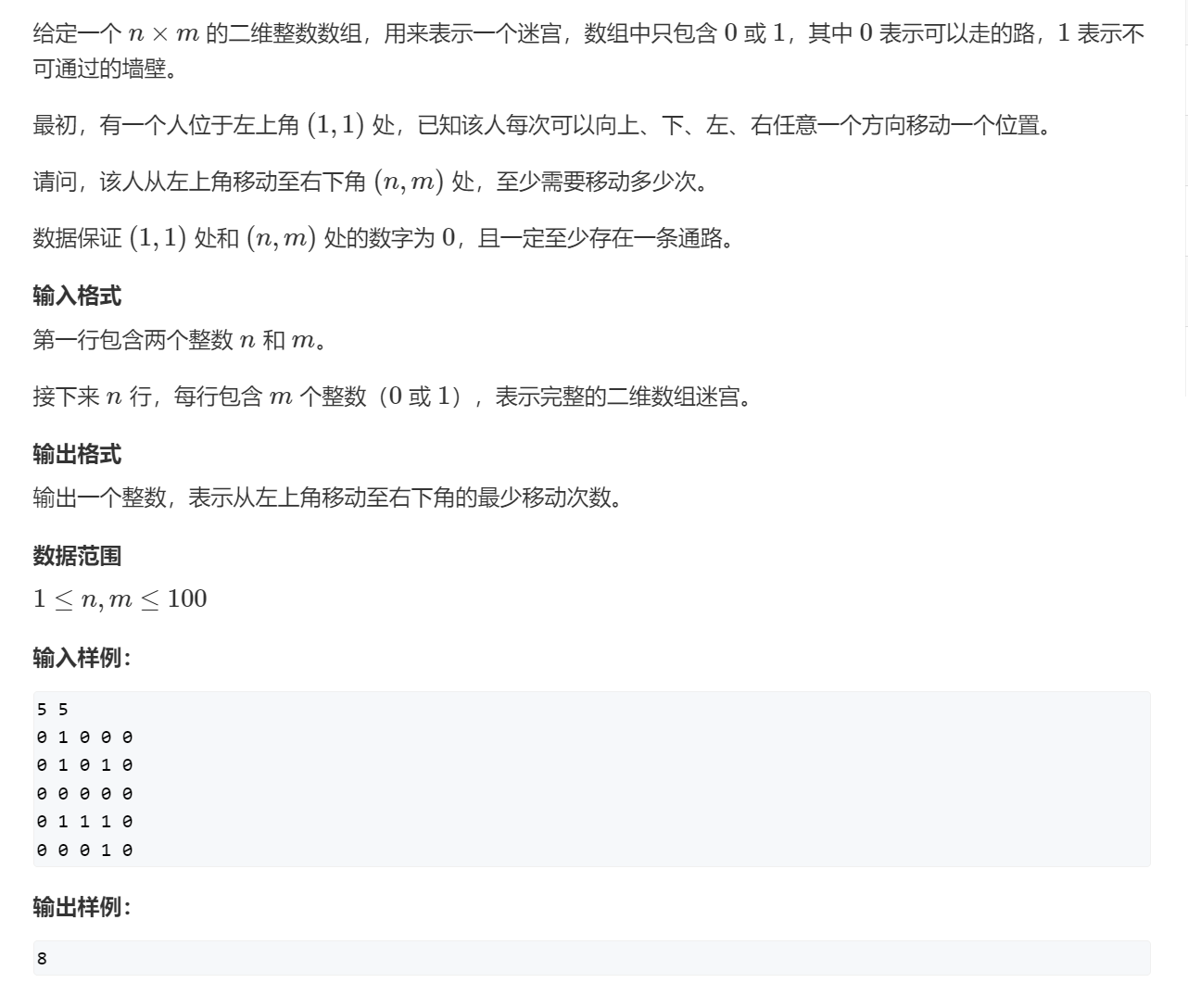走迷宫——BFS
发布时间:2024年01月24日
问题描述

思路
- 声明一个队列,存储走过的位置
- 初始化时,将(0, 0)存入队列中
- 每次从队头弹出一个元素,计算从当前元素能走到哪个位置,如果下一个位置符合条件,那么将下一个位置存入队尾中
- 直到队列中没有元素
代码实现
#include <iostream>
#include <cstring>
#include <algorithm>
using namespace std;
typedef pair<int, int> PII;
const int N = 110;
int n, m;
int d[N][N]; // 表示迷宫,也用来存储走到当前位置的移动次数
PII q[N * N]; // 用数组模拟队列,里面存储的是走过的位置
int bfs()
{
int hh = 0, tt = 0; // hh表示队头,tt表示队尾
q[0] = {0, 0}; // 初始化队列,将(0, 0)存入队列中
int dx[4] = {-1, 1, 0, 0}, dy[4] = {0, 0, -1, 1}; // 上下左右的偏移量
while(hh <= tt) // 队列不为空
{
PII t = q[hh++]; // 弹出队头
for(int i = 0; i < 4; i++) // 上下左右四个方向移动
{
int x = t.first + dx[i], y = t.second + dy[i]; // 从当前位置走到下一个位置
if(x >= 0 && x < n && y >= 0 && y < m && d[x][y] == 0) // 下一个位置在棋盘中、没有走过、没有墙壁
{
d[x][y] = d[t.first][t.second] + 1; // 更新下一个位置的移动次数
q[++tt] = {x, y}; // 将符合条件的下一个位置加入队尾中
}
}
}
return d[n-1][m-1]; // 返回走到(n-1, m-1)这个位置的移动次数
}
int main()
{
cin >> n >> m;
for(int i = 0; i < n; i++)
for(int j = 0; j < m; j++) cin >> d[i][j];
cout << bfs() << endl;
return 0;
}
文章来源:https://blog.csdn.net/m0_73197206/article/details/135817721
本文来自互联网用户投稿,该文观点仅代表作者本人,不代表本站立场。本站仅提供信息存储空间服务,不拥有所有权,不承担相关法律责任。 如若内容造成侵权/违法违规/事实不符,请联系我的编程经验分享网邮箱:chenni525@qq.com进行投诉反馈,一经查实,立即删除!
本文来自互联网用户投稿,该文观点仅代表作者本人,不代表本站立场。本站仅提供信息存储空间服务,不拥有所有权,不承担相关法律责任。 如若内容造成侵权/违法违规/事实不符,请联系我的编程经验分享网邮箱:chenni525@qq.com进行投诉反馈,一经查实,立即删除!
最新文章
- Python教程
- 深入理解 MySQL 中的 HAVING 关键字和聚合函数
- Qt之QChar编码(1)
- MyBatis入门基础篇
- 用Python脚本实现FFmpeg批量转换
- 正向代理和反向代理有什么区别?作为技术你知道吗
- WT2605C音频蓝牙语音芯片:单芯片实现蓝牙+MP3+BLE+电话本多功能应用
- 深度剖析Ajax实现方式(原生框架、JQuery、Axios,Fetch)
- 编码和解码的未来之路
- 99个Python脚本实用实例
- 往数组添加对象的方法
- Cannot read property ‘querySelectorAll‘ of undefined问题解决
- 信息系统建模的三个阶段:资产管理、CMDB、资源管理
- mysql如何取出json里某一个字段或计算两数
- Pycharm 如何更改成中文版| Python循环语句| for 和 else 的搭配使用